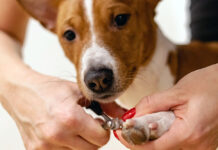If only we could get our pets to brush their teeth regularly! Well you know that can’t happen . . . but we can help our dogs take care of their teeth and gums. They don’t, of course, realize how important dental care is to their health (and maybe you didn’t realize it either).
Following are some facts about dental problems that may either be causing your dog discomfort right now or might soon affect your dog’s health; we’ll also give you some tips on treating those problems.
Gingivitis: Gingivitis is a gum disease that occurs when gum tissue becomes inflamed. If not treated, gingivitis will lead to periodontitis (described below); if it is not treated, gingivitis will cause your dog to start loosing teeth.
Periodontitis: Periodontitis is an advanced gum disease that attacks not only the gums but also the bones that underlie the gums. Commonly called periodontal disease, this is the most common dental problem for dogs. Even relatively young dogs may have Periodontitis or the earlier-stage gum disease, gingivitis.
Imagine a year or two of buildup on your dogs teeth — buildup of plaque, food particles and bacteria. If your dog has gum disease you may not have to imagine it, you will probably be able to see a near-white substance coating the teeth and gums — that’s the result of the bacteria.
Tooth fractures: Dogs love to gnaw on things like bones and when they do they might develop small breaks -fractures of their teeth. Endodontic disease is the name for infections that develop inside these fractures.
Preventing the problems mentioned above is as simple as keeping your dog’s teeth clean. Clean teeth means less bacteria and less bacteria means less disease . . . and the extra bonus of no more ‘doggie-breath.’
Brushing your dog’s teeth. The best way to keep your dog’s teeth clean is by brushing them every day. That may sound like an impossible task but its really not. Over time, if you approach it slowly and lovingly, your dog will accept tooth brushing as an enjoyable daily activity.
Important: If you think that your dog has gum disease or fractured teeth take the dog to a vet to have the condition treated and cleared up before you try brushing the teeth yourself. If the dog has diseased gums, any attempt at tooth brushing may be painful and from then on the dog will associate tooth brushing with pain.
Ideally, you should start brushing a dogs teeth when its a puppy. As a puppy this will be more of a game than a threat and, over time, it will turn into an activity the puppy loves.
If your dog is older and has healthy looking teeth and gums, introduce it to a tooth brush by coating an old toothbrush with something the dog likes to taste; one suggestion is a paste made out of garlic salt and water. Let the dog lick it and even chew on it for just a second. The next day, the dog will recognize the tooth brush in your hand and come running over for another “treat.” Gradually work your way into brushing it’s teeth like that, day-by-day.
Eventually you’ll need to get a toothbrush and toothpaste that is made specifically for pets; you’ll find both in any good pet supply store. It is especially important to find toothpaste that is made for pets; don’t try to use toothpaste made for people. Human toothpaste isn’t intended for ingestion and since your dog can’t ‘spit it out’ you need to get a toothpaste that won’t make the dog sick when some amount is swallowed.
There are two types of pet toothbrushes, one looks like a human toothbrush that is designed to brush a small child’s teeth and the other is a finger brush. A finger brush looks like a large thimble with a pad or bristles mounted on it. Both types of toothbrush are fairly inexpensive so you may want to purchase one of each and see which one works best for you. Either way, as long as the toothpaste tastes good to your dog, it won’t mind you ‘messing around’ in it’s mouth and, eventually, it will even look forward to the daily ritual.
Have your dog’s teeth professionally cleaned. If, for whatever reason, you don’t want to or you can’t brush your dogs teeth yourself, take it to a veterinarian and have the vet give the dog’s teeth a professional cleaning. The vet will sedate your dog and do all the necessary scraping and cleaning of the teeth while the dog is sleeping.
Give your dog a checkup. Its a great idea to give your dog’s mouth a regular checkup. You’ll be looking for any broken, chipped or cracked teeth or any signs that the gums are not healthy. If you see any problems, get the dog to a veterinarian as soon as you can.
Protect your dog’s teeth. Sometimes dogs need to be protected from themselves. A dog will chew on anything and the really hard things like some bones, rocks and other very hard items may eventually crack or break the dog’s teeth. Get rid of the hard stuff and buy your dog some softer chew toys.
Buy some mouthwash for your dog. Nope! Not kidding! There are mouthwash products for dogs and just ignore that mental picture of trying to get your dog to gargle. You just add some of the mouthwash to your dog’s water dish and the mouthwash will not only improve your dog’s breath, it will keep the do’s teeth clean and free of tarter.
As you can see, dogs have dental problems that are very similar to human dental problems and they benefit from dental care just like we do. For all the products suggested here for your dog’s dental care, ask your veterinarian for his or her recommendations on the best products to use. Your vet is your dog’s doctor and should be trusted like you trust your own doctor.




















